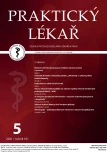Acromegaly – under-diagnosed disease with serious complications
Authors:
J. Smaha; M. Kužma; J. Payer
Authors‘ workplace:
Prednosta: prof. MUDr. Juraj Payer, PhD. MPH, FRCP
; V. interná klinika Lekárskej fakulty Univerzity Komenského a Univerzitnej nemocnice Bratislava, Slovenská republika
Published in:
Prakt. Lék. 2021; 101(5): 282-288
Category:
Case Report
Overview
Despite typical clinical signs, acromegaly is often an under-recognized and under-diagnosed disease. As a result of untreated disease, patients have long-term health problems, often lasting for decades, which reduce their quality of life and increase their morbidity and mortality. Adequate treatment leads to reduction in mortality of patients with acromegaly almost to the level of the general population. Prerequisite for adequate treatment is an accurate and timely diagnostics, which can be complicated by the gradual onset of typical symptomatology. In the present set of case reports we document cases of two men in whom the correct diagnosis was made at random after many years of the disease duration shortly before elective surgery for another cause. Improving awareness of the clinical manifestations of acromegaly and its systemic complications among healthcare professionals could shorten the interval from the onset of symptoms to the final diagnosis.
Keywords:
Growth hormone – Pituitary adenoma – acromegaly – insulin-like growth hormone 1
Sources
1. Vilar L, Vilar CF, Lyra R, et al. Acromegaly: clinical features at diagnosis. Pituitary 2017; 20(1): 22–32.
2. AlDallal S. Acromegaly: a challenging condition to diagnose. Int J Gen Med 2018; 11 : 337–343.
3. Colao A, Grasso LFS, Giustina A, et al. Acromegaly. Nat Rev Dis Primers 2019; 5 : 20.
4. Holdaway IM, Rajasoorya C. Epidemiology of acromegaly. Pituitary 1999; 2(1): 29–41.
5. Extabe J, Gaztamibe S, Latorre P, Vazquez JA. Acromegaly: an epidemiological study. J Endocrinol Invest 1993; 16(3): 181–187.
6. Nachtigall L, Delgado A, Swearingen B, et al. Extensive clinical experience: changing patterns in diagnosis and therapy of acromegaly over two decades. J Clin Endocrinol Metab 2008; 93 : 2035–2041.
7. Gadelha MR, Kasuki L, Lim DST, Fleseriu M. Systemic complications of acromegaly and the impact of the current treatment landscape: an update. Endocr Rev 2019; 40(1): 268–332.
8. Freda PU, Wardlaw SL, Post KD. Long-term endocrinological follow-up evaluation in 115 patients who underwent transsphenoidal surgery for acromegaly. J Neurosurg 1998; 89(3): 353–358.
9. Park HYV, Lansdown A, Taylor P, et al. Acromegaly and the information gap: patient perceptions of the journey from primary to tertiary care. Endocr Connect 2020; 9(10): 971–977.
10. Capatina C, Wass JA. 60 years of neuroendocrinology: acromegaly. J Endocrinol 2015; 226(2): T141–T160.
11. Reid TJ, Post KD, Bruce JN, et al. Features at diagnosis of 324 patients with acromegaly did not change from 1981–2006: acromegaly remains under-recognized and under-diagnosed. Clin Endocrinol 2010; 72(2): 203–208.
12. BennSholmo A, Sheppard MC, Stephens JM, et al. Clinical, quality of life, and economic value of acromegaly disease control. Pituitary 2011; 14(3): 284–294.
13. Boguszewski CL. Acromegaly: You must know it to think of it. Eur J Endocrinol 2020; 183(1): C1–4.
14. Esposito D, Ragnarsson O, Johannsson G, et al. Prolonged diagnostic delay in acromegaly is associated with increased morbidity and mortality. Eur J Endocrinol 2020; 182 : 524–531.
15. Katznelson L, Laws ER, Melmed S, et al. Acromegaly: An Endocrine Society Clinical Practice Guideline. J Clin Endocrinol Metab 2014; 99(11): 3933–3951.
Labels
General practitioner for children and adolescents General practitioner for adultsArticle was published in
General Practitioner

2021 Issue 5
Most read in this issue
- Selected risk factors for stroke
- Bloodless clinical strategies for management of severe anaemia and hemorrhage
- Is the public sufficiently aware about the importance of pertussis vaccination in adulthood?
- Acromegaly – under-diagnosed disease with serious complications
